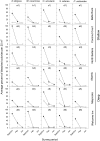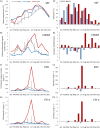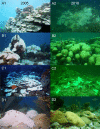Transient turbid water mass reduces temperature-induced coral bleaching and mortality in Barbados
- PMID: 27326377
- PMCID: PMC4911954
- DOI: 10.7717/peerj.2118
Transient turbid water mass reduces temperature-induced coral bleaching and mortality in Barbados
Abstract
Global warming is seen as one of the greatest threats to the world's coral reefs and, with the continued rise in sea surface temperature predicted into the future, there is a great need for further understanding of how to prevent and address the damaging impacts. This is particularly so for countries whose economies depend heavily on healthy reefs, such as those of the eastern Caribbean. Here, we compare the severity of bleaching and mortality for five dominant coral species at six representative reef sites in Barbados during the two most significant warm-water events ever recorded in the eastern Caribbean, i.e., 2005 and 2010, and describe prevailing island-scale sea water conditions during both events. In so doing, we demonstrate that coral bleaching and subsequent mortality were considerably lower in 2010 than in 2005 for all species, irrespective of site, even though the anomalously warm water temperature profiles were very similar between years. We also show that during the 2010 event, Barbados was engulfed by a transient dark green turbid water mass of riverine origin coming from South America. We suggest that reduced exposure to high solar radiation associated with this transient water mass was the primary contributing factor to the lower bleaching and mortality observed in all corals. We conclude that monitoring these episodic mesoscale oceanographic features might improve risk assessments of southeastern Caribbean reefs to warm-water events in the future.
Keywords: Anomalously warm SST; Barbados reefs; Coral bleaching; Coral mortality; Transient water masses.
Conflict of interest statement
The authors declare there are no competing interests.
Figures






Similar articles
-
Caribbean corals in crisis: record thermal stress, bleaching, and mortality in 2005.PLoS One. 2010 Nov 15;5(11):e13969. doi: 10.1371/journal.pone.0013969. PLoS One. 2010. PMID: 21125021 Free PMC article.
-
An evaluation of the effect of recent temperature variability on the prediction of coral bleaching events.Ecol Appl. 2011 Jul;21(5):1718-30. doi: 10.1890/10-0107.1. Ecol Appl. 2011. PMID: 21830713
-
Deep reefs of the Great Barrier Reef offer limited thermal refuge during mass coral bleaching.Nat Commun. 2018 Sep 4;9(1):3447. doi: 10.1038/s41467-018-05741-0. Nat Commun. 2018. PMID: 30181537 Free PMC article.
-
Coral bleaching--capacity for acclimatization and adaptation.Adv Mar Biol. 2003;46:183-223. doi: 10.1016/s0065-2881(03)46004-5. Adv Mar Biol. 2003. PMID: 14601413 Review.
-
Climate change, global warming and coral reefs: modelling the effects of temperature.Comput Biol Chem. 2008 Oct;32(5):311-4. doi: 10.1016/j.compbiolchem.2008.04.001. Epub 2008 May 4. Comput Biol Chem. 2008. PMID: 18565794 Review.
Cited by
-
Turbid reefs moderate coral bleaching under climate-related temperature stress.Glob Chang Biol. 2020 Mar;26(3):1367-1373. doi: 10.1111/gcb.14948. Epub 2020 Jan 8. Glob Chang Biol. 2020. PMID: 31912964 Free PMC article.
-
High-resolution modeling of thermal thresholds and environmental influences on coral bleaching for local and regional reef management.PeerJ. 2018 Feb 16;6:e4382. doi: 10.7717/peerj.4382. eCollection 2018. PeerJ. 2018. PMID: 29473007 Free PMC article.
-
A metagenomic-based study of two sites from the Barbadian reef system.Coral Reefs. 2023;42(2):359-366. doi: 10.1007/s00338-022-02330-y. Epub 2023 Jan 24. Coral Reefs. 2023. PMID: 37009568 Free PMC article.
References
-
- Anthony KRN, Maynard JA, Diaz-Pulido G, Mumby PJ, Marshall PA, Cao L, Hoegh-Guldberg O. Ocean acidification and warming will lower coral reef resilience. Global Change Biology. 2011;17:1798-1808.
-
- Aronson RB, Precht WF. Conservation, precaution and Caribbean reefs. Coral Reefs. 2006;25:441–450. doi: 10.1007/s00338-006-0122-9. - DOI
-
- Ateweberhan M, Fearyb DA, Keshavmurthyc S, Chenc A, Schleyerd MH, Sheppard CRC. Climate change impacts on coral reefs: synergies with local effects, possibilities for acclimation, and management implications. Marine Pollution Bulletin. 2013;74:526–539. doi: 10.1016/j.marpolbul.2013.06.011. - DOI - PubMed
LinkOut - more resources
Full Text Sources
Other Literature Sources

